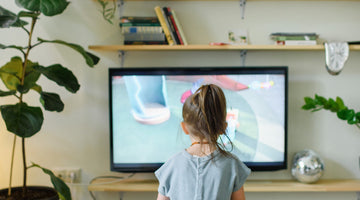
In today's digital age, managing screen time has become a crucial aspect of parenting. With the proliferation of smartphones, tablets, computers, and various digital devices, children and teenagers are spending more time than ever in front of screens.
While technology can offer valuable educational and entertainment opportunities, excessive and uncontrolled screen time can have detrimental effects on a child's physical health, mental well-being, and overall development.
As parents, we are faced with the challenging task of striking a balance between allowing our children to benefit from the digital world and ensuring they don't become overwhelmed by it.
6 Tips For Managing Screen Time Effectively
Understanding Screen Time:
Screen time is a term that has gained immense significance in today's digital landscape. It refers to the amount of time an individual spends interacting with screens, which can include televisions, computers, smartphones, tablets, video game consoles, and other digital devices. To effectively manage screen time for your children, it's crucial to have a clear understanding of what it entails and the various factors that come into play.
Screen time encompasses all activities that involve looking at or engaging with a screen. This can range from watching movies and television shows to playing video games, using social media, browsing the internet, and even educational activities conducted on screens.
- Age-Appropriate Screen Time Guidelines:
One crucial aspect of understanding screen time is recognizing that what is suitable for one age group may not be appropriate for another. Age-appropriate screen time guidelines can help you determine how much screen time is reasonable for your child.
These guidelines often take into account developmental stages, with younger children benefiting from less screen time compared to older teenagers.
Understanding screen time is the first step in developing effective strategies to manage it. It's essential to approach screen time management with a balanced perspective, recognizing both the potential benefits and risks associated with screen use.
Impact of Excessive Screen Time:
Excessive screen time, especially among children and adolescents, has raised concerns among parents, educators, and healthcare professionals. While screens have become an integral part of modern life, it's crucial to understand the potential negative consequences of spending too much time in front of them. Excessive screen time can affect various aspects of a child's life, including their physical health, mental well-being, and overall development.
Physical Health Effects:
-
Sedentary Lifestyle: Spending excessive time in front of screens often means less physical activity. This sedentary lifestyle can contribute to health issues such as obesity, poor muscle development, and cardiovascular problems.
-
Sleep Disruption: The blue light emitted by screens, especially in the evening, can disrupt sleep patterns. This can lead to sleep deprivation, which can negatively impact a child's cognitive functioning, mood, and overall health.
-
Eye Strain: Prolonged screen use can cause eye strain, leading to symptoms like dry eyes, headaches, and blurred vision.
Mental Health Consequences:
-
Reduced Social Interaction: Excessive screen time can limit face-to-face social interactions, which are essential for developing social skills and emotional intelligence.
-
Increased Stress and Anxiety: Exposure to certain online content, such as cyberbullying or distressing news, can contribute to increased stress and anxiety levels among children and teenagers.
-
Depression: Some studies suggest a correlation between excessive screen time and symptoms of depression, particularly when it leads to social isolation or exposure to harmful content.
Academic and Social Implications:
-
Reduced Academic Performance: Spending too much time on screens can detract from time spent on homework and studying, potentially leading to lower academic performance.
-
Decreased Attention Span: Constant exposure to screens with fast-paced content can contribute to shorter attention spans, which can be detrimental in educational settings.
-
Social Development Challenges: Children and teenagers who spend excessive time on screens may face challenges in building and maintaining real-world relationships, which are crucial for their social development.
It's important to note that not all screen time is harmful. Educational content, creative expression through technology, and positive online interactions can have benefits. The key is to strike a balance and ensure that screen time doesn't overshadow other essential aspects of a child's life, such as physical activity, face-to-face socialization, and academic pursuits.
In the following sections, we will explore strategies to mitigate the negative effects of excessive screen time and promote a healthy, balanced approach to technology use in the family.
Setting Screen Time Limits:
Establishing clear and reasonable screen time limits is a fundamental step in managing your child's technology use effectively. While screens offer various benefits, unchecked and unlimited access can lead to excessive screen time, which can have negative consequences on physical and mental health. Setting appropriate limits helps strike a balance between the digital world and other essential aspects of life.
Here's how you can go about it:
Determining Age-Appropriate Screen Time Limits:
-
Consult Expert Guidelines: Consider guidelines provided by reputable organizations such as the American Academy of Pediatrics (AAP) or your country's equivalent. These guidelines often recommend specific daily or weekly screen time limits based on a child's age.
-
Consider Individual Needs: While general guidelines are useful, remember that every child is unique. Factors such as your child's temperament, interests, and maturity level should influence your screen time decisions.
Creating a Family Screen Time Policy:
-
Involve Your Children: Include your children in the process of setting screen time limits. Discuss the reasons behind these limits and encourage them to be part of the decision-making process. This can promote a sense of responsibility and cooperation.
-
Set Clear Rules: Establish clear and consistent rules regarding when and how screens can be used. This includes specifying screen-free times, such as during meals or before bedtime.
-
Limit Screen Access: Consider setting up parental controls and access restrictions on devices to enforce screen time limits. Many devices and apps offer features that allow parents to manage and monitor screen time effectively.
Setting Daily and Weekly Screen Time Goals:
-
Allocate Time for Different Activities: Encourage a balanced approach to screen time by allocating specific time blocks for different activities. For example, designate time for homework, physical activity, and recreational screen time.
-
Track Screen Time: Keep track of your child's screen time to ensure they stay within the established limits. There are apps and built-in device features that can help you monitor screen time.
-
Reward System: Consider implementing a reward system where your child earns additional screen time for completing chores, reading, or engaging in other productive activities.
-
Model Healthy Screen Use: Be a role model by demonstrating responsible screen use. Children often learn by example, so your behavior can influence their attitudes toward technology.
-
Regularly Review and Adjust: As your child grows and their needs change, be prepared to review and adjust screen time limits accordingly. Flexibility is key to accommodating their evolving interests and responsibilities.
Setting screen time limits requires a balance between ensuring your child's well-being and allowing them to enjoy the benefits of technology. It's important to approach this process with empathy and open communication, as it helps foster a positive attitude toward responsible screen use within your family.
Creating a Screen-Free Zone:
Designating specific areas in your home as screen-free zones is an effective strategy for managing screen time and promoting healthier habits. These zones provide a physical space where screens are not allowed, encouraging alternative activities and fostering better family connections.
Here's how to create a screen-free zone in your home:
Importance of Designated Screen-Free Areas:
-
Promotes Face-to-Face Interaction: Screen-free zones encourage family members to engage in conversations and activities that require direct interaction, enhancing social bonds.
-
Reduces Screen-Related Distractions: By eliminating screens from certain spaces, you can create environments conducive to focus, relaxation, and quality time together.
-
Enhances Sleep Quality: Designating bedrooms as screen-free zones can improve sleep quality by preventing late-night screen use, which can disrupt sleep patterns.
Ideas for Creating a Screen-Free Zone at Home:
-
The Dining Room: Make mealtime a screen-free experience by setting a rule that no screens are allowed at the dining table. This promotes mindful eating and meaningful family conversations.
-
The Living Room: Designate your living room as a screen-free area, encouraging family members to read, play board games, engage in hobbies, or simply relax without the distraction of screens.
-
Bedrooms: Keep screens out of the bedroom, especially for children and teenagers. Charging devices in a common area overnight can help prevent late-night screen use.
-
Outdoor Spaces: Extend your screen-free zones to outdoor areas like the backyard or patio. These spaces provide opportunities for physical activity and outdoor play.
-
Home Office: If you have a home office, consider setting specific hours for screen use within this space. After work or study hours, encourage family members to disconnect from screens in this area.
Enforcing Screen-Free Times:
-
Consistency: Ensure that screen-free rules are consistently applied. Make it a family commitment to respect these boundaries.
-
Communication: Explain the importance of screen-free zones to your family, emphasizing the benefits of disconnecting from screens in certain areas.
-
Create Alternatives: Provide alternatives to screen time in these zones, such as books, puzzles, art supplies, or musical instruments. Make these alternatives easily accessible.
-
Lead by Example: As parents, be role models by adhering to screen-free zone rules. Demonstrate your commitment to creating tech-free spaces.
-
Use Positive Reinforcement: Offer praise and rewards for family members who follow the screen-free rules consistently.
Creating a screen-free zone in your home is a proactive step toward managing screen time and fostering a healthy tech balance within your family. These designated spaces can help everyone disconnect from screens, focus on real-world activities, and strengthen relationships with loved ones.
Monitoring and Tracking Screen Time:
In an era where screens are ubiquitous, it's important for parents to actively monitor and track their children's screen time to ensure it remains within healthy limits. Effective monitoring not only helps you stay informed about your child's digital activities but also provides an opportunity for open communication and guidance.
Here are some strategies for monitoring and tracking screen time:
Parental Control Tools and Apps:
-
Set Up Parental Controls: Many devices and platforms offer built-in parental control features that allow you to limit screen time, block inappropriate content, and track usage. Familiarize yourself with these tools and use them to establish boundaries.
-
Use Third-Party Apps: There are numerous third-party apps available that provide detailed insights into your child's screen time habits. These apps often offer customizable settings and real-time tracking.
-
Device Agnostic Solutions: Some parental control solutions work across various devices and platforms, ensuring consistent monitoring regardless of the device your child uses.
How to Effectively Monitor Screen Time:
-
Establish Clear Guidelines: Set clear expectations for your child's screen time, including when and where screens are allowed and for how long. Ensure your child understands these rules.
-
Regularly Check Usage: Take time to review your child's screen time activity on their devices. This can be done daily or weekly, depending on your preferences.
-
Discuss Online Activities: Engage your child in conversations about their online activities. Ask them about the games they play, the websites they visit, and the people they interact with online. Encourage them to report any concerning or inappropriate content.
-
Balance Screen Time: Encourage a balance between screen time and other activities such as physical play, reading, and socializing. Use monitoring as a tool to ensure this balance is maintained.
-
Respect Privacy: While it's important to monitor screen time, also respect your child's privacy. Let them know you're monitoring for their safety and well-being, not to invade their privacy.
Open Communication with Children:
-
Explain the Reasons: Have open and honest discussions with your child about why you're monitoring their screen time. Emphasize the importance of staying safe online and maintaining a healthy tech balance.
-
Encourage Responsibility: Teach your child about responsible screen use and the potential consequences of excessive or inappropriate screen time. Encourage them to self-regulate as they grow.
-
Address Concerns: If you come across any concerning behavior or content during your monitoring, address it with your child calmly and constructively. Use these incidents as teaching moments.
-
Listen Actively: Be receptive to your child's experiences and concerns about their digital life. Create a safe space for them to share their online experiences with you.
Monitoring and tracking screen time is a proactive approach to ensuring that your child's digital activities align with your family's values and expectations. It allows you to guide them toward responsible tech use while keeping them safe in the digital world.
Encouraging Alternative Activities:
In the quest to manage screen time effectively, it's essential to provide children with compelling alternatives to digital devices. Encouraging a balanced lifestyle that includes a variety of activities not only reduces excessive screen time but also promotes holistic development.
Here are some strategies for encouraging alternative activities:
Promoting Physical Activities:
-
Outdoor Play: Encourage your child to spend time outdoors engaging in physical activities like running, biking, playing sports, or simply exploring nature. Outdoor play supports physical health and stimulates creativity.
-
Family Walks: Make family walks a routine. It's an excellent way to bond, get some fresh air, and add physical activity to your daily routine.
-
Sports and Hobbies: Enroll your child in sports, dance, or other physical activities they enjoy. Encourage them to pursue hobbies like painting, gardening, or cooking that keep them engaged and active.
Fostering Intellectual Growth:
-
Reading: Create a reading-friendly environment at home with a variety of books that cater to your child's interests and reading level. Make regular trips to the library to explore new titles.
-
Educational Games and Puzzles: Introduce educational games and puzzles that challenge your child's cognitive skills while having fun. These can be both digital and non-digital.
-
STEM Activities: Engage your child in STEM (Science, Technology, Engineering, and Mathematics) activities like building with blocks, conducting simple experiments, or exploring coding through educational apps or kits.
Encouraging Creative Expression:
-
Art and Crafts: Provide art supplies and encourage your child to express themselves through drawing, painting, or crafting. Display their creations proudly to boost their self-esteem.
-
Music and Dance: Support your child's interest in music or dance by providing instruments or dance classes. It's a fantastic way for them to channel their energy and creativity.
-
Storytelling: Encourage your child to create and share their own stories, whether through writing, drawing, or oral storytelling. This enhances their imagination and communication skills.
Promoting Social Interaction:
-
Playdates: Arrange playdates with friends to foster social interaction. Allow your child to develop social skills, share experiences, and build friendships.
-
Family Time: Dedicate quality family time without screens. Play board games, cook together, or embark on family outings to strengthen bonds.
Setting Tech-Free Zones:
-
Designate Tech-Free Times: Set specific times during the day when screens are not allowed, such as during meals or before bedtime.
-
Create Screen-Free Zones: As discussed earlier, establish screen-free zones in the house, such as the dining room and bedrooms, to encourage alternative activities.
Reward and Positive Reinforcement:
-
Use Positive Reinforcement: Reward your child with praise, special privileges, or small incentives for engaging in alternative activities and adhering to screen time limits.
-
Acknowledge Achievements: Celebrate your child's milestones and achievements in their non-digital pursuits. Recognize their efforts and progress.
Encouraging alternative activities not only reduces screen time but also enriches your child's life by providing them with diverse experiences. It's important to be patient and supportive as they explore new interests and hobbies, as this can lead to a more balanced and fulfilling lifestyle for your family.
Conclusion:
Effective management of screen time is a journey that parents embark on to ensure their children grow up with a healthy relationship with technology. In this guide, we've explored the various aspects of screen time management, from understanding what screen time entails to setting limits, creating screen-free zones, monitoring and tracking, and encouraging alternative activities.




